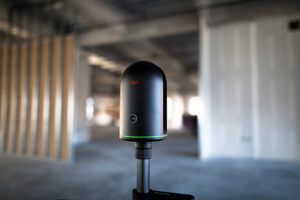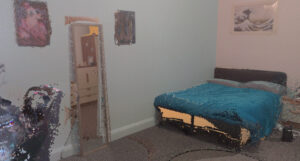Over the past week I have had the great pleasure to have the first hands-on contact with LiDAR technology. It has been days of a great deal of experimentation, understanding its potentials, and limitations. Many considerations made about such new technology and full of wonders, so it seemed appropriate for me to hereby make some of my own as I document through this first encounter.

This hands-on experience was only possible thanks to the uCreate studio of University of Edinburgh, who provided the loan service and respective workshops, and to whom we as group acknowledge and thank their amazing efforts.
The loaned device was the Leica BLK360 pro 3D (Figure 2), a LiDAR scanner described by many as one of the smallest and intuitive of its kind. However, its size and simplistic design deceive the user on a first glance. This device is capable of capturing full-color panoramic images overlaid on a high accuracy point cloud, showing accuracy on distances up to 60 meters, and capable of capturing HDR images, even in low-light settings thanks to a small integrated LED. To sum up, small but powerful, simple but full of potencial.

The first interactions performed were made at home, in somewhat 3 small places: a large bedroom, a smaller bedroom and modest sized living room. The first scan performed was contemplated with great excitement as it had already surpassed my own expectations, even though this did not use its full resolution, used a single scan point, and was performed at low-light without its flash setting (an honest rookie mistake…). Right after, I moved this experience to the living room, where I first encountered possibility of linking multiple scans, which once found to have a “automatic pre-allignement” feature made the whole interaction even more intuitive. The results now were showing even more interest, as its capability of capturing a place with high-fidelity was now coming to light, even though I was still using those same “rookie” settings (Figure 3).

It was when I moved the device to my own bedroom that I finally found its full technical capabilities. I now understood there to be 3 point cloud concentration settings, to which I have till then used its quicker yet more dispersed scan. With the full-resolution settings a lot of personal considerations and excitement from the results surfaced. After combining the results of four full-resolution scans, the results went further and beyond expected. Not only they constructed a high-fidelity point cloud coloured 3D model of my bedroom, but it also showed other interesting aspects of these scans. The first being, that once positioned close to the window, the device managed yo accurately scan the street outside, which opens the possibility of looking over the idea of place that goes further than its “inclosed doors”. The other interesting opportunity found, was how the device dealt with the presence of a mirror. It was understood that scan constructs a mirror place as a 3D model to, surfacing the possibility of looking upon of creating a place that not only contrasts its mirrored dimension, but also makes it real (Figure 4).

Summing up, the first touch on LiDAR technology already shows a lot of possibilities and prospects for an AV project that looks upon the conceptualisation and questioning of the meaning of “place”, as it can both capture place but also synthesise its own.
Further considerations on this technology will for sure came about, and so we’ll keep it being posted.
David Ivo Galego, 1st of February 2023.


One thought on “David – Getting to know LiDAR”